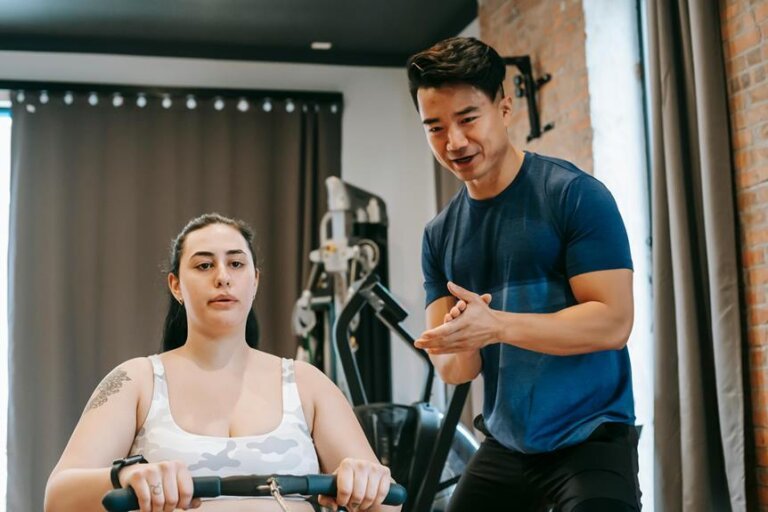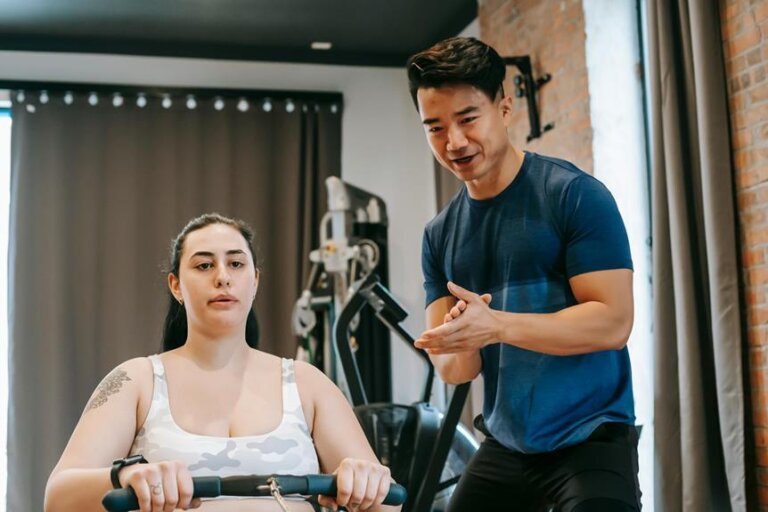The Ultimate Guide to Building Lean Muscle as a Woman
Imagine sculpting a masterpiece from a slab of marble; it's a meticulous process that demands patience, skill, and a well-thought-out plan, isn't it?
That's exactly how you should approach building lean muscle as a woman. You've likely heard the old myth that weightlifting will make you bulky, but that's just not true.
It's time to break down these misconceptions and guide you on your journey to a stronger, leaner you. But how do you start? What should you eat? Which exercises are best?
Let's explore together, shall we?
Understanding Women's Muscle Anatomy
While it may seem complex, understanding your muscle anatomy as a woman is a crucial first step towards effectively building lean muscle. You've got over 600 muscles in your body, all with unique roles and structures. These muscles are made up of individual muscle fibers, which contract and relax to generate movement and strength.
Let's focus on the two main types of muscle fibers: slow-twitch (type I) and fast-twitch (type II). Slow-twitch fibers are endurance-oriented and are what you use for long, sustained activities like running or cycling. Fast-twitch fibers, split into type IIa and type IIb, are used for short, intense movements such as lifting weights or sprinting.
As a woman, you naturally have a higher proportion of slow-twitch fibers. This doesn't mean you can't build fast-twitch fibers, it just means you'll have to work a bit harder. Incorporating both endurance and strength training into your routine can help balance the development of both fiber types, leading to leaner and more defined muscles.
Debunking Female Muscle-Building Myths
Let's tackle some muscle-building myths that often misguide women.
You've probably heard that building muscle will make you bulky, or maybe you're swayed by misinformation about muscle gain.
We'll clear up these misconceptions and shed light on the realities of strength training.
Busting Bulking Fears
Despite the pervasive myth, lifting weights won't automatically bulk you up, particularly if you're a woman. Your body's hormonal makeup is different from a man's and doesn't support massive muscle gain without significant supplementation and intense, focused training.
So, toss out that fear of morphing into a bodybuilder after a few weight training sessions. You won't. Instead, you'll tone your muscles, improve your strength, and enhance your overall body composition.
It's time to dispel the myth and embrace the fact that lifting weights is a powerful tool for female fitness. It's about strength, not size. So, grab those weights with confidence, knowing you're working towards a leaner, stronger you. Don't let unfounded fears hold you back from achieving your fitness goals.
Muscle Gain Misinformation
Now, we're going to tackle some common misconceptions about muscle gain in women, breaking down those myths that may have been preventing you from pursuing your strength training goals.
Firstly, many believe that lifting weights will make you bulky, but that's not the case. Women typically have less testosterone than men, making it harder for us to grow large muscles.
Secondly, it's a myth that muscle turns into fat when you stop working out. Muscle and fat are different types of tissue, so one can't transform into the other.
Lastly, don't fall for the misconception that cardio is the only way to lose weight. While it helps, strength training also plays a crucial role in weight loss by boosting your metabolism.
Demystifying Strength Training
So, you're interested in strength training but swamped with myths and misconceptions about women building muscle? Let's clear that up.
First, lifting weights won't make you bulky. Women typically have less muscle tissue and produce less testosterone than men, making it harder to gain massive muscle mass.
Second, muscle doesn't weigh more than fat—it's just denser. Therefore, strength training can actually help you lose weight by increasing your metabolic rate.
Lastly, strength training isn't just for the young. It's beneficial at any age, and especially important for older women to maintain bone density.
Don't let these myths deter you from your fitness goals. Embrace strength training and experience its numerous benefits.
Tailoring Your Nutrition for Muscle Gain
Let's now focus on how to structure your diet for muscle gain.
You'll need to understand the concept of caloric surplus, recognize the crucial role of protein in muscle growth, and master the art of balancing macros for gains.
Understanding Caloric Surplus
While you're striving to build lean muscle, understanding the concept of a caloric surplus – consuming more calories than your body burns – is critical to correctly tailor your nutrition for muscle gain. When your body operates in a caloric surplus, it has extra energy to fuel muscle growth.
But it's not about gorging on any food in sight; it's about quality, balanced nutrition. You'll need a mix of carbs for energy, healthy fats for hormone regulation and satiety, and of course, proteins, without diving into their role just yet.
Protein's Role in Growth
Understanding the essential role of protein in muscle growth can drastically improve your muscle-building efforts. Protein is the building block of muscle. When you exercise, you're essentially tearing your muscles down, and it's protein that rebuilds them stronger and bigger.
For optimal muscle growth, you need to consume enough protein regularly. It's recommended you get at least 0.6 to 1 gram of protein per pound of body weight daily. This can come from lean meats, dairy, eggs, and plant-based sources like beans and lentils.
Balancing Macros for Gains
To maximize muscle gain, you need to strategically balance your macro intake, including proteins, carbohydrates, and fats. You've heard it before, protein is key for muscle repair and growth, but carbs and fats are equally crucial. Carbohydrates fuel your workouts and aid recovery, while fats support hormone production and overall health.
A good starting point is a macro split of 40% protein, 40% carbs, and 20% fats. To personalize this, adjust based on your body's response. If you're feeling sluggish during workouts, up your carb intake. If you're not seeing muscle growth, consider increasing protein. Remember, everyone's body responds differently. Learn to listen to yours and tweak your macros to support your muscle-building journey. You've got this!
Essential Workouts for Lean Muscle
If you're aiming to build lean muscle, incorporating specific workouts into your routine is absolutely crucial. Let's dive into essential exercises that'll help you sculpt a stronger, leaner body.
Start with strength training. It's a must for muscle building as it pressures your body to use more muscle fibers, accelerating growth. You'll want to focus on compound movements like squats, deadlifts, bench presses, and lunges, as they work multiple muscle groups simultaneously, promoting more muscle growth and burning more calories.
Next, don't overlook high-intensity interval training (HIIT). It's an efficient way to burn fat while preserving muscle. By alternating between short, intense bursts of exercise and short rest periods, you'll increase your metabolic rate for hours after the workout, promoting muscle growth.
The Role of Supplements in Muscle Building
While workouts are key, you shouldn't underestimate the impact of supplements on your muscle-building journey. They can help you replenish nutrients, stimulate muscle growth, enhance recovery, and improve your overall performance.
Supplements like protein powders provide the necessary building blocks for muscle growth. They're not magic, but they make it easier to meet your daily protein needs, especially when you're on the go.
BCAAs, or branched-chain amino acids, are another great choice. They aid in muscle recovery and can help you work out harder and longer. Creatine, on the other hand, boosts your strength and power during high-intensity workouts, making each session more effective.
Don't forget about vitamins and minerals, either. Iron, for instance, plays a crucial role in oxygen transport and energy production. Calcium and vitamin D are essential for bone health, which is crucial when you're lifting weights.
Maintaining Your Progress: Long-term Strategies
After you've nailed down your workout routine and supplements, it's vital to focus on strategies that ensure your progress is ongoing and sustainable. You've worked hard to build that lean muscle, so don't let your efforts go to waste.
First, it's crucial to set long-term goals. Keep your fitness journey exciting by challenging yourself. Whether it's lifting heavier weights, running longer distances, or mastering a new exercise, there's always something to strive for.
Second, consistency is key. You can't expect to maintain your progress if you're not consistent with your workouts and nutrition. Make it a point to hit the gym regularly and stick to your diet, even on days when you don't feel like it.
Third, don't forget to rest. Overtraining can lead to injuries and hinder your progress. Listen to your body, and take rest days when needed.
Lastly, keep track of your progress. Use a fitness app, keep a workout journal, or take progress photos to visualize your achievements. This isn't just motivating, but it also allows you to adjust your routine if you hit a plateau. Remember, building lean muscle is a journey, not a destination.
Frequently Asked Questions
How Does Hormonal Changes During Menstruation Affect Muscle Building in Women?
Your hormonal changes during menstruation can impact muscle building. Estrogen levels drop, which can lead to fatigue, making workouts tougher. It's harder to build muscle when you're not able to push as hard.
Does the Process of Building Lean Muscle Differ Between Pre-Menopausal and Post-Menopausal Women?
Yes, it does differ. As you transition from pre-menopause to post-menopause, hormonal changes cause muscle loss. You'll need to adjust your exercise and diet to maintain or build lean muscle during this phase.
What Are Some Potential Health Risks or Injuries That Can Occur From Incorrectly Performing Muscle-Building Exercises?
If you're not careful in performing muscle-building exercises, you could face risks like strains, sprains, or fractures. Incorrectly lifting weights might damage joints, while overexertion can lead to dehydration or heart problems.
Are There Specific Muscle-Building Exercises That Should Be Avoided During Pregnancy?
Yes, you should avoid exercises that put pressure on your abdomen during pregnancy. This includes heavy weightlifting and exercises that require lying flat on your back. Always consult with your doctor before starting any exercise regimen.
How Can I Balance Muscle-Building Exercises With Cardio for a Well-Rounded Fitness Routine?
Balancing muscle-building exercises with cardio isn't too tricky. You just need to alternate days, focusing on strength training one day, then cardio the next. This ensures you're getting a well-rounded workout without overdoing it.
Conclusion
In the end, sculpting your body into a lean machine isn't a sprint, but a marathon. Don't be disillusioned by myths or deterred by setbacks.
Feed your body the right fuel, engage in efficient workouts, consider supplements, and remember to prioritize sustainability.
The journey to lean muscle isn't merely about physical transformation; it's a testament to your strength, resilience, and dedication. Embrace this journey and reap the rewards of your hard-earned metamorphosis.






